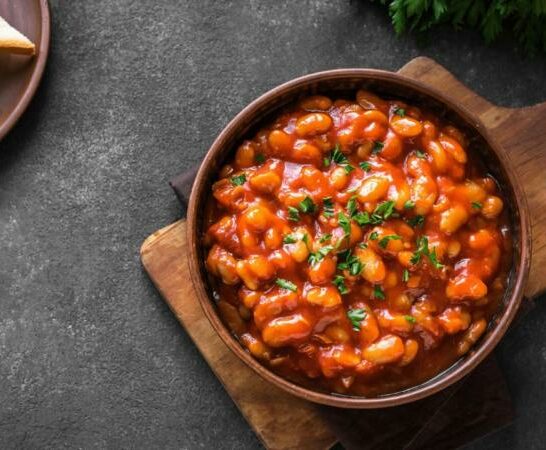Canned beans are an excellent staple to have on-hand in the pantry, as they can be a quick and easy protein for a healthy meal anytime.
Plus, canned beans remove a lot of the time and effort that goes into preparing and cooking dried beans.
Chili is a popular family favorite that highlights the simple chili bean- but what is the best way to prepare beans in chili?
Do you drain beans for chili?
Yes, you should drain beans when adding them to your homemade chili, but with some exceptions. For instance, if you are using flavored and seasoned chili beans, do not drain them- this would rinse away all your spices and flavor! Also, drain beans anytime you are watching your sodium levels as most beans are packed in liquid that contains salt.
Do you like chili? Keep reading to learn more tips for making your own!
Making Chili with Beans
So, you are making a batch of chili with a can of kidney or pinto beans- do you drain them?
The short answer is ‘yes’, go ahead and drain the beans.
Give your beans a good rinse with cool water in a colander before you add them to your chili mixture.
Some of the reasons why you should rinse them are to get rid of the sticky liquid that can sometimes alter or thicken the chili (not necessarily bad things) and to control the amount of sodium and salt in your chili.
Beans are usually packed with salt, so it makes sense to rinse this away before adding to your favorite recipes.
Now, if you are using chili beans specifically, you may not want to rinse them before adding them to the chili pot.
Chili beans are cooked pinto beans that are usually canned in a savory, spicy sauce that enhances the chili and that makes for a quick and easy chili recipe.
Keeping the beans in their own liquid can make for a very flavorful and simple chili that already has garlic, tomato, pepper, cumin, and chili powder added- as well as other spices so read the label to know what ingredients are in the chili beans.
Again, if you are watching your salt intake, make sure to know what the sodium is in your canned beans, of any type.
Food researchers found that draining beans can remove over one-third of the sodium used in canning them, so plan accordingly.
Consumers should also be aware that canned beans- including chili beans- are prepared with an ingredient called calcium chloride, which is used to prevent the beans from getting mushy and unappealing to eat.
Some don’t mind this thick liquid, but others don’t care for the flavor that it adds to the dish.
Also, removing it cuts down on the starchiness of the calcium chloride- but if you need to thicken your chili, keep some of the canning liquid in.
Making Chili without Beans
So, what to do if you don’t eat beans?
Some folks have difficulty digesting legumes, so it could be that chili con carne (or chili without beans) is a better option.
This is a dish that puts the attention on the ground meat in the chili.
This is also a great option for folks adhering to low-carb diets, like Keto, or that are looking for a meaty, high-protein chili that they can top rice, burgers, or hot dogs with!
To make your own, brown your ground beef, chicken, or turkey in a deep pan.
Drain the fat before adding garlic, cumin, and chili powder to taste. Stir well and continue to cook.
Add tomato sauce and broth to thin out the chili and cook until the mixture boils.
Cover your chili and simmer for at least an hour. If the chili becomes too thick, add water to thin it out to your desired taste.
Another approach is to thin your chili out with a bit of beer- most kinds will work- which also adds to the flavor profile and complexity of your chili recipe.
Frequently Asked Questions About Draining Chili for Chili Beans
What is the best kind of beans to use in chili?
Chili beans take some of the work out of making chili as these types of canned beans usually contain spices like cumin, chili powder, oregano, and garlic, so you don’t have to add them yourself. Kidney beans are a popular bean in chili as they are firm, flavorful, and hold up to the cooking process well.
What can you substitute for chili beans?
You can substitute any kind of cooked, canned bean for chili beans- just make sure to adjust seasonings accordingly. Pinto and kidney beans make excellent replacements for seasoned chili beans.
How do you make chili with no beans?
Chili without beans- or chili con carne- is made similarly to chili with beans except that ground meat is the star of the show. The spices and preparation are essentially the same, but with more time and attention given to the meat and sauce rather than the beans.
What is the best ground beef to use for making chili?
For healthier chili, look for a 90% lean variety- or ground turkey! For any other chili, 80% lean ground beef provides flavorful fat that enhances the finished product.
Conclusion
Where do you stand on draining beans when making chili- and what kind of beans do you use for your own recipe?
Use these tips to determine whether to drain or not to drain your beans when concocting your own chili- you may be surprised by how tasty it turns out.
If you decide that you are not a chili bean fan, consider another option to enjoy the flavor profile of a great chili-like chili without beans or chili con carne, instead!

